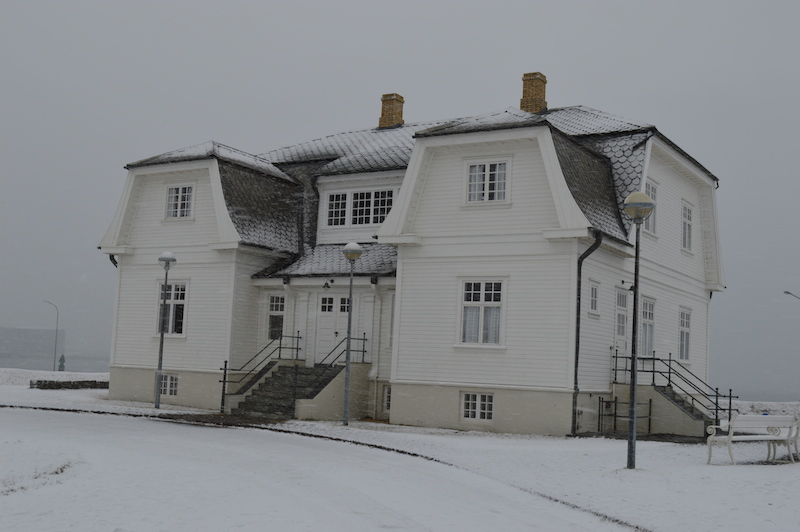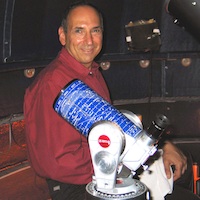by David Levy
- Published: Tuesday, April 08 2014 05:13
Last fall I had the pleasure of having a conversation with Mike Simmons at the annual Arizona Science and Astronomy Expo in Tucson. We have known each other for many years, and even, last year, AWB joined together briefly with our Sharing the Sky Foundation for our annual Star Night at the University of Arizona. This year's Star Night, on April 5, 2014, features at least 20 telescopes spread out across the Mall at the University of Arizona. From 3 pm, to sunset we look safely at the Sun, monitoring sunspots and prominences. After dark we have the Moon, Jupiter, Mars, and denizens of the deep sky to explore and admire.
It is amazing how the sky over the University of Arizona is so clear despite light pollution from the University itself. One year we watched in awe as the International Space Station soared over us. The next time we see it will have its own space telescope aboard, the ISEREVE hyperstar camera and Celestron telescope originally made for amateur astronomers. The telescope aboard the station actually peers Earthward, to photograph the scenes of natural disasters and other unplanned events.
Our purpose, as is everything we do with Sharing the Sky, is to inspire people to want to look at the stars. Together with AWB we have a beautiful opportunity to spread the night sky around the world.

This extends to other nighttime phenomena as well. Wendee and I recently visited Iceland, certainbly one of the most remote parts of Earth. One of the highlights was a late evening trip to see a very small display of aurora borealis. The weather was frightful, with two major storms, one of which kept us holed up at a convenience store for almost five hours. We were a few yards from the beach, to the south of which was the volcanic island of Surtsey which was created in November of 1963. Not only did the weather not allow us to see the island, but also we could not even see the beach!
Since Iceland is at the south end of the northern auroral arc, displays are frequent there. We did see some faint glows, including one on the plane traveling to Iceland the first night, and a small system of rays, but no major displays.
One highlight for us occurred the very first day of the trip. We saw Hofdi House, an interesting old and large wooden structure in Reykjavik, It was the site of the 1986 summit meeting between Ronald Reagan and Mikhail Gorbachev. At the time the meeting was considered a failure, since no real items were agreed to. However it marked the start of a process which rapidly led to a growing friendship between these two leaders and a real thaw and calming down of relationships between two big countries. I took this photograph of the house during my visit. Our guide mentioned how Reagan cut a dashing figure as he strolled through the city.
The meeting took place in 1986, a few months after Halley's comet rounded the Sun. In ancient times, the comet was considered an omen. But in 1986, with scientific understanding of comets at a peak, it was just another event during that momentous year.
###
 Dr. David H. Levy, Wendee’s Husband. A short bio for a tall man. David H. Levy is arguably one of the most enthusiastic and famous amateur astronomers of our time. Although he has never taken a class in astronomy, he has written over three dozen books, has written for three astronomy magazines, and has appeared on television programs featured on the Discovery and the Science Channels. Among David’s accomplishments are 23 comet discoveries, the most famous being Shoemaker-Levy 9 that collided with Jupiter in 1994, over 500 asteroid discoveries, an Emmy for the documentary Three Minutes to Impact, five honorary doctorates in Science and a PhD which combines astronomy and English Literature. Currently, he is the editor of the web magazine Sky’s Up! David continues to hunt for comets and asteroids, and lectures worldwide.
Dr. David H. Levy, Wendee’s Husband. A short bio for a tall man. David H. Levy is arguably one of the most enthusiastic and famous amateur astronomers of our time. Although he has never taken a class in astronomy, he has written over three dozen books, has written for three astronomy magazines, and has appeared on television programs featured on the Discovery and the Science Channels. Among David’s accomplishments are 23 comet discoveries, the most famous being Shoemaker-Levy 9 that collided with Jupiter in 1994, over 500 asteroid discoveries, an Emmy for the documentary Three Minutes to Impact, five honorary doctorates in Science and a PhD which combines astronomy and English Literature. Currently, he is the editor of the web magazine Sky’s Up! David continues to hunt for comets and asteroids, and lectures worldwide.








Comments